#Neue Sorbische Kunst
Text



'Decolonize Sorbian Settlement Area'
Digital Collage, 375 x 375 mm, 2024
Fine Art Pigment Print under Acrylic Glass,
Black Aluminium Art Box
Lets talk about decolonization of the sorbian settlement area. My recent project of artistic research.
#neue sorbische kunst#nsk#bernhard schipper#leipzig artist#nsk folk art#sb2130#sorbian artist#nsk state lipsk#Decolonization#anti colonialism#SorbianSettlementArea#SorbischesSiedlungsbebiet#SerbskiSydlenskiRum#SerbskiSedleńskiRum#autochthon#indigen#artisticresearch#selfdetermination#fundamentalrights#Indigenous#postcolonial#Dekolonisierung
7 notes
·
View notes
Text

'mmmmmmmake Bismarck Čornobóhgreatagainnnnnnn'
2021/2023
#nsk#neue sorbische kunst#neue slowenische kunst#nsk folk art#nskstatelipsk#nsk state in time#bismarck#czorneboh#cornoboh#schwarzer gott#black god#bautzen#battleship#warship#monument#upper lusatia#oberlausitz#sorben#sorbisch#sorbian#sorbs
1 note
·
View note
Photo
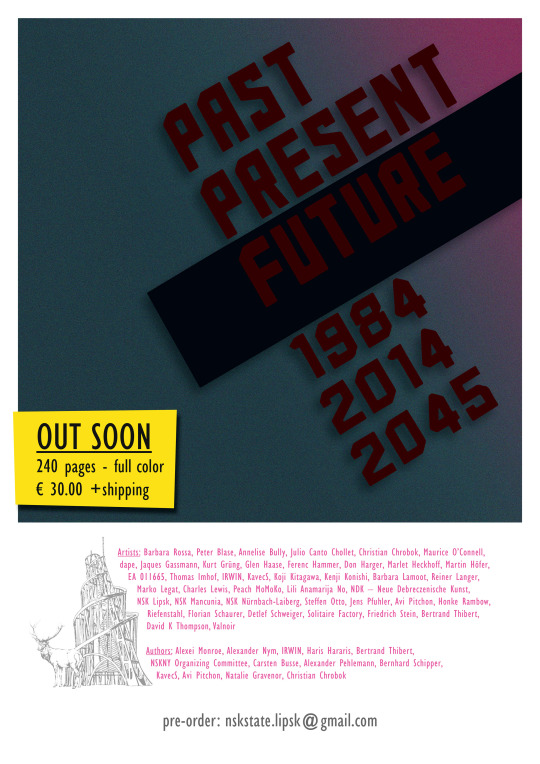
OUT SOON:
Catalog 1st NSK Folk Art Biennale ‘Past - Present -Future’
pre-order: [email protected]
#NSK#NSK State#NSK State Lipsk#Neue Sorbische Kunst#Catalog#IRWIN#Laibach#Neue Slowenische Kunst#Alexei Monroe#Zonic#Alexander Pehlemann#Carsten Busse#Solitaire Factory#Alexander Nym#Bernhard Schipper#Riefenstahl#NSK Staat#Micro Nation#Spinnerei Leipzig#Exhibition#Avi Pitchon#Christian Chrobok#Peter Blase#retrogardism#slovenia#state in time
9 notes
·
View notes
Photo

OUT SOON:
Catalog 1st NSK Folk Art Biennale ‘Past - Present -Future’
pre-order: [email protected]
1 note
·
View note
Text

'Coat Of Arms'
The city coat of arms of 'Bautzen/Бауцен' with its heraldic coloring blue/yellow and its iconic town wall with additional 'Україна/Ukraine' lettering.
Shortly after Russias invasion into Ukraine some right wing citizens of Bautzen destroyed and removed blue/yellow flags in the city. BUT the coat of arms colors of Bautzen and Upper Lusatia are blue and yellow.
#nsk#nsk folk art#nsk lipsk#nskstate#Ukraine#Neue Sorbische Kunst#sb2130#Україна#Oberlausitz#Bautzen#Військовий злочинець Путін#coat of arms#stadtwappen#b96begradigen
9 notes
·
View notes
Text

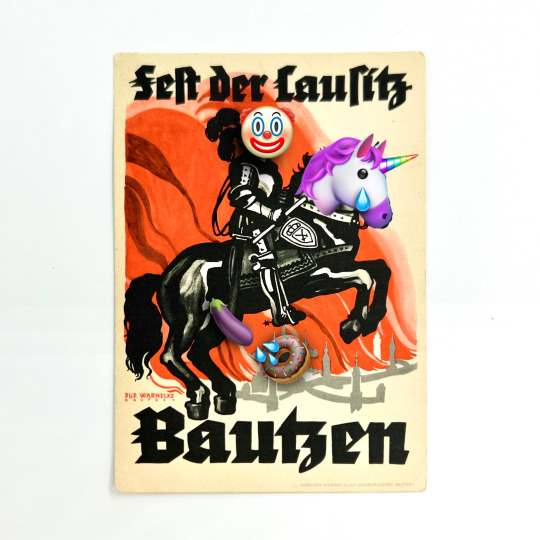



'Decolonize - Die Ravensteiner Gurke'
Digital Collage, 375 x 375 mm, 2024
Fine Art Pigment Print under Acrylic Glass,
Black Aluminium Art Box
Die Ravensteiner Gurke
Hutzenstuben, Trutzburgen, oder Oh-Oh-Oh (doch kein) Osterreiter
Die hölzernen - manieristisch - druckgeschwärzten - expressiv - gotischen Schnitte des tausendjährigen Bautzens von Rudolf Warnecke erfreuen sich quer durch alle bildungsverbrämten Gruppen jeglicher politischer Couleur immer noch großer Beliebtheit und sind in vielen Haushalten, die ich in der Oberlausitz kenne, noch im Original zu finden. Die Buchhandlungen sind voll dieser Trutzburgen-Heimelei, welche den wohligen Schauer dunkler Zeiten der zweimal abgefeierten (1933 und 2002) tausendjährigen Geschichte als Souvenir mit den TouristInnen den Weg nach Hause finden - nachdem die Kurzweilenden der indizierten T-Shirt Freakshow auf dem Kornmarkt überdrüssig geworden sind.
Ich bin mit diesen altertümlichen Bildern meiner Geburtsstadt aufgewachsen und empfand immer ein gewisses Unbehagen beim Anblick dieser schon zu der Zeit ihrer Entstehung aus der Zeit gefallenen Darstellungen dieser Stadt. Gewiss sind einige dieser Holzschnitte ikonisch in der Darstellung der Stadt und ich möchte dem Schöpfer nicht das Handwerk als Holzschneider absprechen. Aber es fehlt mir an kritischer Einordnung und Reflektion aller AkteurInnen in der Oberlausitzer Kulturlandschaft zu einem Künstler und seinem Werk, der noch 1942 in der ‚Großen Deutschen Kunstausstellung‘ mit der Arbeit ‚Stillende Mutter‘ vertreten war. Dann 1943 ein Titelbild für die Zeitschrift ‚Deutsche Leibeszucht‘. Anzumerken ist, dass der Künstler wegen seiner Weigerung, in die NSDAP einzutreten, gegen Ende des Krieges seine Anstellung als Ausstellungsleiter am Stadtmuseum Bautzen verlor und zum Heeresdienst eingezogen wurde. Soweit so normal: Ein Karriereknick reichte bei vielen nach dem Krieg als Beleg für den Widerstand gegen das Naziregime.
Der zugegeben härteste Triggerpunkt für mich war, als Anfang diesen Jahres in Görlitz eine kleine Ausstellung gezeigt wurde, die den Künstler in eine Reihe mit Alwin Brandes, Hanka Krawcec, Johannes Wüsten, Paul Sinkwitz und Rosa Luxemburg stellte. Das expressiv erstarrte, alle Stadtbrände überdauernde Hexenhaus, als das Symbolbild eines tausendjährigen Bautzen neben einer Abbildung aus dem Herbarium von Rosa Luxemburg schmerzt dann doch sehr. Der Diskurs darüber blieb aus oder drang nicht durch ins oberste Stübchen meines gläsernen Elfenbeinturms im fernen Leipzig.
Vor einigen Wochen fand ich eine Ansichtskarte, welche für das ‚Fest der Lausitz‘ 1935 gestaltet wurde und 1941 immer noch im Umlauf war - wie die Stempel auf mehreren erhaltenen Exemplaren belegen. Der schwarze ‚Ritter‘ auf seinem schwarzen Hengst vor dem brennenden Bautzen. Ist es eine Szene aus dem Dreißigjährigen Krieg, als die kurfürstlichen Sachsen (das Wappen auf dem Schild lässt es vermuten) die Stadt belagerten? In der Folge dieser kriegerischen Auseinandersetzungen wurde das böhmische Bautzen samt dem Markgraftum Oberlausitz 1635 den Sachsen zugeschlagen. Die Perspektive, dreihundert Jahre später, ist eine großdeutsche und Rudolf Warnecke weiß den gewünschten Ton des Regimes zu treffen, welches die geplante Kolonisierung der ‚Ostgebiete‘ mit Ereignissen wie dem ‘Fest der Lausitz’ historisch begründen will. Ab 1937 wurde sorbisches Leben systematisch unterdrückt.
In einer Region, die 79 Jahre nach Kriegsende regelmäßig in der Presse wegen rechter Verhaltensauffälligkeiten gewürdigt wird und sich darüber jedes Mal ungerecht behandelt fühlt, ist der Künstler immer noch im kulturellen Mainstream verankert. Ich empfinde diese Trutzburgen-Kreuzritter-Ästhetik als zutiefst Slawen-feindlich und nicht im geringsten die Ursprünge dieser zweisprachigen Region und Heimat einer autochthonen Bevölkerungsgruppe widerspiegelnd. Die - hoffentlich nicht - kommende blau-schwarze Regierung frohlockt ob dieser braunäugigen Sehschwäche. Regelmäßig erscheinen vor meinem inneren Auge rotierende Rundumleuchten, wenn dieser Tage der Künstler und sein Werk aufploppen. Das ist nicht zwingenderweise der Aufruf zum Bildersturm, sondern lediglich eine Aufmunterung, mal eine andere und ich betone, nicht-identitäre Perspektive einzunehmen.
#SB2130#Bernhard Schipper#Neue Sorbische Kunst#leipzig artist#nsk folk art#Decolonization#anti colonialism#SorbianSettlementArea#SerbskiSydlenskiRum#SerbskiSedleńskiRum#SorbischesSiedlungsgebiet#Bautzen#Budyšin#Wenden#Sorben#Serbja#Serby#sorbisch#Sorbs#autochthon#indigen#postcolonial#artisticresearch#RudolfWarnecke#undoingcolonialism
3 notes
·
View notes
Text
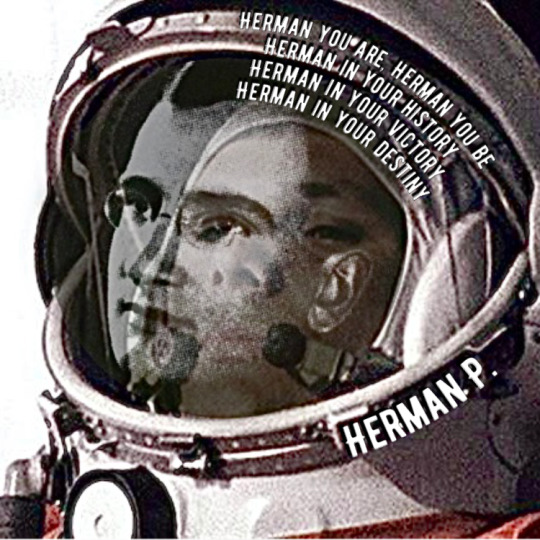
'Herman P.'
Digital Collage, 2023
I took the lyrics of 'Roman P.' by Psychic TV and changed 'Roman' to 'Herman'
Lyrics:
Herman you are, Herman you be
Herman in your history
Herman in your victory
Herman in your destiny
[Chorus:]
Are you free, are you really free?
Are you really, really, really, really, really free?
Is it you or is it me?
Or is it simply history?
Are you free, are you really free?
Are you really, really, really, really, really free?
Is it you or is it me?
Or is it simply jealousy?
...
Oh, oh Herman, oh Herman
Herman P.
#hermann noordung#herman potocnik#nsk#nsk folk art#neue slowenische kunst#neue sorbische kunst#spacehistory#spacetravel#roman p#psychic tv#genesis p orridge#yuri gagarin#space pioneer#der raketen motor#nsk state lipsk#nsk lipsk#nsk state in time#sb2130#Cosmokinetic Cabinet Noordung#Red Pilot Theater#Gledališče sester Scipion Nasice#center noordung#The Problem of Space Travel#Das Problem der Befahrung des Weltraums#Raketen Motor#Cultural Centre of European Space Technologies#KSEVT
4 notes
·
View notes
Text
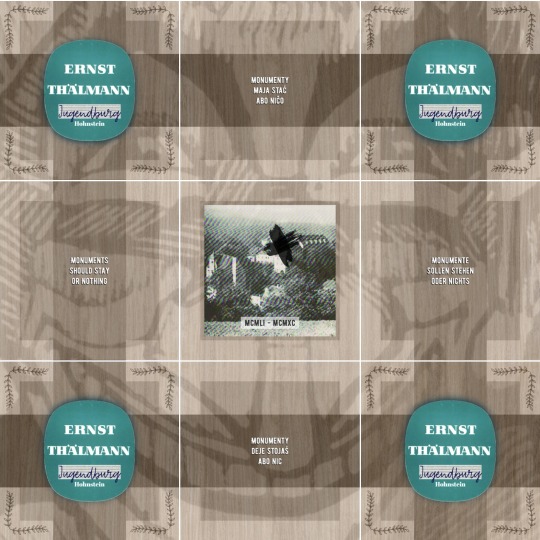
'Monumente sollen stehen oder nichts - Hohnstein’
Digital Collage, 375 x 375 mm, 2024
Fine Art Pigment Print under Acrylic Glass,
Black Aluminium Art Box
Based on the series 'Monumente sollen stehen oder nichts', which deals with Ernst Thälmann, his monuments in the GDR and the treatment of other socialist monuments after the political change in 1989, this picture cycle deals with places that bore the name Ernst Thälmann and have disappeared.
#sb2130#Bernhard Schipper#NSK#Neue Sorbische Kunst#German History#NSK Folk Art#Ernst Thälmann#DDR#KPD#Working Class Hero#Arbeiterführer#Hohnstein#Jugendburg#Puppentheater#Jugendherberge#Konzentrationslager#Internierungslager#Hohnstein Kasper#Leipzig Art#Leipzig Artist#Sorbian Artist#Autochthon#Sorbian
0 notes
Text

'Die Huldigung des Peter H.’
Digital Collage, 375 x 375 mm, 2024
Fine Art Pigment Print under Acrylic Glass,
Black Aluminium Art Box
#sb2130#Bernhard Schipper#Neue Sorbische Kunst#NSK#Peter Huchel#Bodenreform#Sorbian Artist#Leipzig Artist#NSK Folk Art#Flurbereinigung#Enteignung#Sachsen#Landwirtschaft#Agriculture#Bauern#Farmer#Dorf#Sorbisch#Folk Art#Volkskunst#Sorbian#Slavic#Autochthon#Upper Lusatia
0 notes
Text

'Monumente sollen stehen oder nichts - Oberhof’
Digital Collage, 375 x 375 mm, 2024
Fine Art Pigment Print under Acrylic Glass,
Black Aluminium Art Box
Based on the series 'Monumente sollen stehen oder nichts', which deals with Ernst Thälmann, his monuments in the GDR and the treatment of other socialist monuments after the political change in 1989, this picture cycle deals with places that bore the name Ernst Thälmann and have disappeared.
The second part of the new 'Monuments' series addresses the historical stratifications that made the originally insignificant village of Oberhof in Thuringia into a social and sporting center of German history from the imperial era through the Third Reich to the showpiece location of the GDR . I consciously chose a motif from the Ernst Thälmann House, which also contains the monument to Duke Ernst II. A deer with her fawn looks at the building from this perspective. The monument was not removed during GDR times - only the reference to Duke Ernst II was replaced by the city coat of arms of Oberhof. The silhouette of the deer appears shadowy in the wood grain of the background, which appears to be looking at the viewer and looking down at the deer in the picture.
The green signet with the Ernst Thälmann lettering, which was used in the first picture in the series, was originally designed for the Ernst Thälmann House restaurant in Oberhof. It is one of the original references for this dysfunctional place of remembrance, in which historical events from several eras overlap without being processed. The whole setup in this folksy kitschiness in the absence of any modernity illustrates the petty bourgeois nature of GDR socialism.
#sb2130#Bernhard Schipper#NSK#Neue Sorbische Kunst#Ernst Thälmann#Oberhof#Ernst Thälmann Haus#Leipzig Artist#Sorbian Artist#Sorbian Art#Monument#DDR#KPD#Working Class Hero#Thuringia#Rennsteig#Winter Sports#Olympics#HerzogCarlEduard#German History#NSK Folk Art#Neue Slowenische Kunst
0 notes
Text

‘50th Anniversary of NSK - January 1st, 1974’
Digital Collage, 375 x 375 mm, 2023
Fine Art Pigment Print under Acrylic Glass,
Black Aluminium Art Box
Nothing is further from my mind than to promote the no longer existing East German state by showing GDR symbolism while drunk with nostalgia. For some time now, however, badges from the GDR era have been appearing increasingly, which suggest that New Sorbian Art existed long before the political change in 1989. The badges mentioned show a deer or the head with antlers and oak leaves with the GDR coat of arms in the lower part and are made of cast metal or plastic. The deer is one of the visual anchors in the NSK universe.
An embossed lignite briquette recently appeared in an online auction house, which shows the identical deer motif as on the badge as well as the year '1974' and the words 'Prosit Neujahr (Happy New Year)' in two lines. Should this commemorative briquette be proof of the founding date of the New Sorbian Art? Then the East German NSK would have been founded on January 1st, 1974. It has not yet been possible to reconstruct where exactly this founding meeting took place in Lusatia on the night of December 31st to January 1st, 1974.
Time doesn't just move forward linearly. Traveling back in time on a timeline changes reality there as well as here in the now. It is impossible to imagine what would happen to the 'NSK State In Time' if, at sufficient speed, the space-time curvature made travel in parallel universes of the 'NSK State In Time' possible.
But wait a minute - the tree for the national identity of the Sorbs is the linden tree. But don't the oak leaves show that we are on the wrong track.
#sb2130#Bernhard Schipper#Neue Sorbische Kunst#NSK#Neue Slowenische Kunst#NSK State in Time#NSK State Lipsk#50 Jahre NSK#50.Jahrestag#50th Anniversary#Leipzig Artist#Sorbian Artist#nsk folk art
1 note
·
View note
Text

‘Aktivist’
Digital Collage, 375 x 375 mm, 2023
Fine Art Pigment Print under Acrylic Glass,
Black Aluminium Art Box
‘Activist’ is probably the most totalitarian-seeming image in the series so far. The composition consists only of visual set pieces of the socialist hero glorification in the mining industry and the German miners' song 'Vor dem Anfahren' from the Mansfelder Land from 1797. I tried to reduce the aggressive expression - not particularly successfully. Until I realized that the elements such as: danger of being buried, community, omnipresent death, uniforms, and (the built-up) ideal of serving the people are inherent in the theme and I have to accept this in order to complete the picture.
Mining is war against Earth - our home planet.
I have to admit that I have had little contact with the mining culture so far. But since the beginning of the 1990s at the latest, it has been clear that mining in Germany is a phased-out model - an industry with no future due to dwindling resources, high environmental pollution and the health consequences for employees. But politicians in eastern Germany in particular cling to the myth that fossil resources never run out - also because they have failed to develop sustainable alternatives and perspectives. Mining has caused irreparable damage to the landscape and has irrevocably destroyed autochthonous culture, especially in the opencast mining areas of East Germany. Mining companies criminally mislead the public when it comes to water extraction from ecosystems.
Ultimately, the glorification of fossil fuel industries can no longer be justified. This is not to deny the achievements, hardships and sacrifices made by miners and their families for centuries. The picture is dedicated to them.
#sb2130#Bernhard Schipper#Aktivist#Neue Sorbische Kunst#Leipzig Artist#Sorbian Artist#nsk folk art#Mining#Laibach Kunst#Neue Slowenische Kunst#Sketches Of The Red District#Bergbau#Montan#Miner#Glück Auf
2 notes
·
View notes
Text
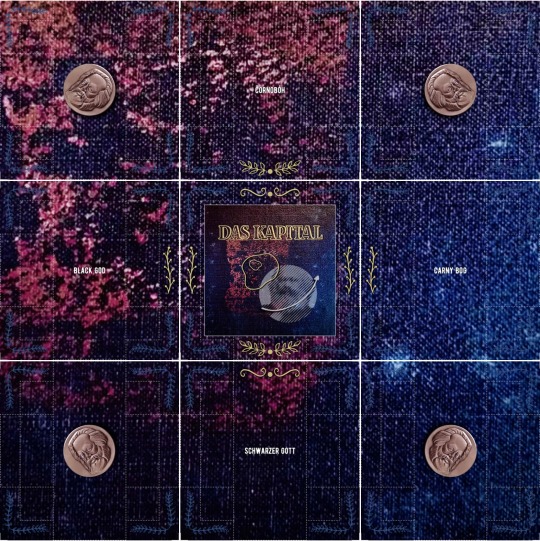
‘Black God - Eternal Denim’
Digital Collage, 375 x 375 mm, 2023
Fine Art Pigment Print under Acrylic Glass,
Black Aluminium Art Box
Everything is folk art. For my current series I use almost exclusively graphic pieces from the Internet - more precisely screenshots from Ebay. It's a game of low pixel density, blurring, poor lighting and crooked angles.
Similar to folk art, where the content, the formal and the passing on of tradition are in the foreground and the perfect craftsmanship, achieved with excellent tools, seems less important - in my work the perfect templates are not necessary for the sake of the statement.
The age-related discolored book cover, which becomes denim due to insufficient image resolution, blurring and exaggerated color curves and the trick of adding copper coins to the indigo, takes on something eternal through its technical reproducibility. Or is it just a washed-out image of the depths of space?
Karl Marx's visionary analysis of the exploitation of the means of production and their omnipresence, which is committed to constant growth, rejects eternal capitalism, since the process logically ends in self-destruction.
#sb2130#Bernhard Schipper#Neue Sorbische Kunst#NSK#NSK State Lipsk#Leipzig Artist#Sorbian Artist#Blacl God#Schwarzer Gott#Corno Boh#Czorneboh#Karl Marx#Capitalism#Philosopher#Communism#Zeitstrahlbild
1 note
·
View note
Text
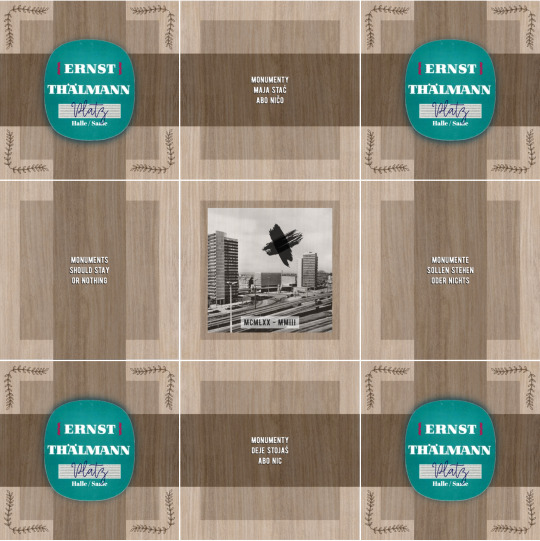
'Monumente sollen stehen oder nichts - Halle/Saale’
Digital Collage, 375 x 375 mm, 2023
Fine Art Pigment Print under Acrylic Glass,
Black Aluminium Art Box
Based on the series 'Monuments should stay or nothing', which deals with Ernst Thälmann, his monuments in the GDR and the treatment of other socialist monuments after the political change in 1989, this picture cycle deals with places that bore the name Ernst Thälmann and have disappeared.
The beginning of this new series is Ernst-Thälmann-Platz in Halle/Saale, which is probably the most radical urban redevelopment in the GDR. The square, which is now called Riebeck-Platz again, has undergone a complete renovation and dismantling over the last twenty years. Just as the GDR ensemble erased all traces of pre-war development, so that no element of the original development exists today.
In the graphic implementation I use the socialist folklore typical of the GDR, from the oak veneer to the green patch with anachronistic serif lettering.
#sb2130#Bernhard Schipper#NSK#Neue Sorbische Kunst#Ernst Thälmann#Halle#Saale#Leipzig Artist#Sorbian Artist#Ostmoderne#NSK Folk Art
0 notes
Text

'Landnahme’
Mixed Media / Digital Collage, 375 x 375 mm, 1993/2023
Fine Art Pigment Print under Acrylic Glass,
Black Aluminium Art Box
In the exhibition ‘XXX years of Zonic’ a small photograph of an early picture of Neue Sorbische Kunst from 1993 was on display. It is a mixed media image which shows in the center of the image an early computer graphic of a memorial plaque for the fallen high school graduates in World War I at the Bautzen high school. The crossed memorial plaque is flanked by heads from the sculpture 'Sitting Old Couple' by the Bautzen sculptor Horst Weiße. The original picture was framed in a wooden picture frame by the Upper Lusatian sculptor Jürgen Spottke.
The original background was an original neo-expressive painting of mine from 1989, which I painted on an old foam rubber-coated stage structure of the German-Sorbian Folk Theater. Later I treated the painting surface with plaster, salt and golden metal pigment, so that a living picture was created that reacted to the respective environmental conditions by sweating or oxidizing.
The picture was in my father's collection and was lost after his death. It was part of a series of mixed media images, all of which no longer exist. Now, with the help of artificial intelligence, I tried to increase the resolution of the image to bring out details. Ultimately, this attempt only shows the limitations of current artificial intelligence, which is not able to deal with abstract or unknown image content.
As part of the timeline images, the mixed media series has a certain relevance, so I show the current status of the reconstruction and, if necessary, publish a new version of the image from time to time.
#sb2130#Bernhard Schipper#NSK#Neue Sorbische Kunst#NSK State Lipsk#Leipzig Artist#Sorbian Artist#NSK Folk Art#riefenstahl#nsk state in time
0 notes
Text

'Leitmotiv’
Digital Collage, 375 x 375 mm, 2023
Fine Art Pigment Print under Acrylic Glass,
Black Aluminium Art Box
Ernst Thälmann belongs to the DNA of early New Sorbian art. The performance “Monuments should stand or nothing” on April 16, 1991 at the Ernst Thälmann Monument in Bautzen was the first (public) collaboration between the Riefenstahl artist group. Based on the performance, two publications and three short films were created, as well as a number of pictorial works that are not represented in the publications.
The special thing about the Bautzen Thälmann Monument is that its creator, Wieland Förster, was imprisoned in Bautzen as a teenager, just like Thälmann. This historical charge also sets it apart from the GDR workers' and farmers' kitsch of other Thälmann monuments.
In the spirit of the folk artistic examination of the GDR role model of a hero, Ernst Thälmann offers an almost inexhaustible reservoir of image material that literally calls out to be recycled and sampled. Here is another variant of the German workers' leader, who was shamefully played along in a historical sense and who has a permanent place in the ancestral gallery of tragic heroes at NSK.
The original Thälmann monument by Wieland Förster with the preserved traces of the Riefenstahl performance from 1991 has now found a place in the Bautzen Memorial Museum, which is accompanied by video excerpts from the performance. The three-part video was most recently shown at the ‘XXX years of Zonic’ exhibition in Leipzig.
#sb2130#Bernhard Schipper#NSK#Neue Sorbische Kunst#NSK State Lipsk#Ernst Thälmann#Momument#Working Class Hero#Communism#KPD#Leipzig Artist#Sorbian Artist
0 notes